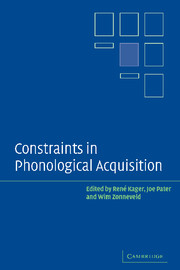Book contents
- Frontmatter
- Contents
- List of contributors
- Abbreviations
- Preface
- 1 Introduction: constraints in phonological acquisition
- 2 Saving the baby: making sure that old data survive new theories
- 3 Markedness and faithfulness constraints in child phonology
- 4 Input elaboration, head faithfulness, and evidence for representation in the acquisition of left-edge clusters in West Germanic
- 5 Phonological acquisition in Optimality Theory: the early stages
- 6 Syllable types in cross-linguistic and developmental grammars
- 7 Bridging the gap between receptive and productive development with minimally violable constraints
- 8 Learning phonotactic distributions
- 9 Emergence of Universal Grammar in foreign word adaptations
- 10 The initial and final states: theoretical implications and experimental explorations of Richness of the Base
- 11 Child word stress competence: an experimental approach
- Index of subjects
- Index of names
5 - Phonological acquisition in Optimality Theory: the early stages
Published online by Cambridge University Press: 22 September 2009
- Frontmatter
- Contents
- List of contributors
- Abbreviations
- Preface
- 1 Introduction: constraints in phonological acquisition
- 2 Saving the baby: making sure that old data survive new theories
- 3 Markedness and faithfulness constraints in child phonology
- 4 Input elaboration, head faithfulness, and evidence for representation in the acquisition of left-edge clusters in West Germanic
- 5 Phonological acquisition in Optimality Theory: the early stages
- 6 Syllable types in cross-linguistic and developmental grammars
- 7 Bridging the gap between receptive and productive development with minimally violable constraints
- 8 Learning phonotactic distributions
- 9 Emergence of Universal Grammar in foreign word adaptations
- 10 The initial and final states: theoretical implications and experimental explorations of Richness of the Base
- 11 Child word stress competence: an experimental approach
- Index of subjects
- Index of names
Summary
Introduction
The study of phonological acquisition at the very earliest stages is making notable progress. Virtuosic experimental work accessing the linguistic knowledge of infants has yielded extraordinary findings demonstrating the precocity of some aspects of acquisition. Moreover, phonologists now possess an important resource, Optimality Theory (OT) (Prince and Smolensky 1993), which permits theorising to relate more closely to the findings of experimental work. The purpose of this chapter is to outline one way in which these experimental and theoretical research lines can be brought closer together. The central idea is that current phonological theory can, without essential distortion, be assigned an architecture that conforms closely to the process of acquisition as it is observed in children. I conclude with a speculative, though reasonably comprehensive, picture of how phonological acquisition might proceed.
Empirical focus
To avoid confusion, I will try to make clear that my view of what ‘phonological acquisition’ involves may be broader than the reader is predisposed to expect.
When we study how very young children learn language, we can follow two paths. One is to examine what children say; the other is to develop methods that can determine what children understand or perceive. The reason these two methods are so different is that (by universal consensus of researchers) acquisition is always more advanced in the domain of perception than production: children often cannot utter things that they are able to perceive and understand.
- Type
- Chapter
- Information
- Constraints in Phonological Acquisition , pp. 158 - 203Publisher: Cambridge University PressPrint publication year: 2004
- 85
- Cited by



